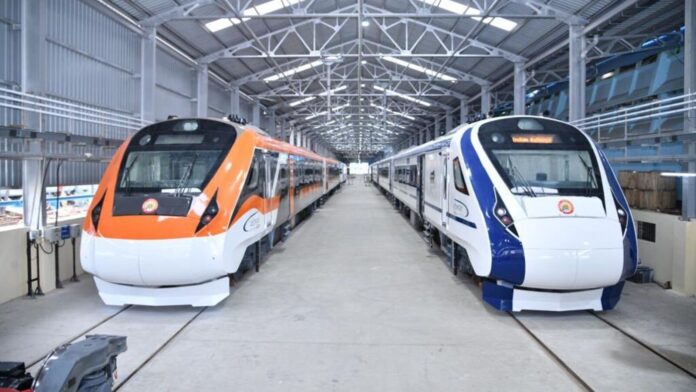In the National Capital Region (NCR), the Regional Rail Rapid Transit System (RRTS), or RapidX, is being built on dedicated standard gauge tracks that will connect places up to 250km away from Delhi over viaducts or underground tunnels. RapidX trains have a top speed of roughly 180km per hour and an average speed of roughly 90kmph, and the average distance between stops is about 7km. But RRTS corridors are only for the NCR, not the rest of India.
Nationwide, to travel between a major city and its distant outer suburban towns up to 250km away, there is often the choice of an air service available, but since it may be costlier and an end-to-end journey can take long this way (airport time must be considered), flying is not always the best option for passengers.
Although National Highways have been developed to connect major cities with smaller towns, practical limitations mean the average bus travel speed rarely exceeds 70kmph. Conventional rail services can carry people at 55-85kmph, whether it is a mail or express train, or even a premium service. Car travel may offer 90kmph average speed, but highways are not always safe and there may be traffic congestion along the way. This is what makes Vande Bharat Metro an attractive proposition for quick and safe travel.
Just as Vande Bharat trains can operate at a top speed of 130kmph if the rail infrastructure supports such a pace, Vande Bharat Metro trains can also do the same—as the design specifications of the propulsion system are similar for both. However, Indian Railways will have to address many issues before effectively operating Vande Bharat Metro trains.
The tracks in suburban regions and beyond are extremely congested, as Indian Railway runs both suburban and non-suburban trains simultaneously. This is why non-suburban trains often reach major cities earlier than their arrival time if it is before the day’s suburban services have begun, but may get delayed if they are later than that, as long-distance trains are sometimes made to wait for a track-usage time-slot between frequent suburban services.
The real issue for Indian Railways is not the speed capability of its ‘rolling stock’ (trains, i.e.), but how far it has equipped its infrastructure to run its high-speed trains to the best of their capacity. If Vande Bharat Metro trains can run at an average speed of 100kmph (80% of maximum design speed), they would do wonders on various counts.
For instance, a popular route from Chennai to Tirupati of 110km by loco-haul train takes about 3 hours and 35 minutes. The Vande Bharat Metro, with faster acceleration and deceleration, could cover this distance in less than 2 hours if the rail infrastructure supports this speed.
Vande Bharat Metro trains are unreserved trains. Each coach can accommodate 100 seated passengers and 200 standees. If we look at the average travel of passengers in various service classes, it is about 600km, 850km, 830km, 410km, 890km and 350km for First-class AC, Second-class AC, Third-class AC, Chair Car, Sleeper and Second-class (unreserved general compartment), respectively, for Mail and Express trains.
So, Vande Bharat Metro trains are appropriate for second-class passengers for their distance requirements. Indian Railways has been operating Mail/Express, Ordinary (slow-moving passenger trains) and EMU/MEMU trains for distances of 100km to 350km.
Vande Bharat trains should get passengers from these trains as well as from bus and car travellers. But there is a catch for Indian Railways. The average fare a traveller pays for second-class travel in Mail/Express, Ordinary and EMU/MEMU trains has been 45 paisa/km, 22 paisa/km and 18 paisa/km, respectively.
The utterly low fares for these services over the decades pose a legacy problem, as rail passengers compare these with the high fares for Vande Bharat trains. Although EMU/MEMU travel is not very comfortable—their rakes don’t even have toilets aboard services that run up to 150km—it is a cheap option for commuters. Daily and frequent users typically prefer to economize.
When Indian Railways introduces Vande Bharat Metro trains on routes currently plied by EMU/MEMU services, it will be difficult to set fares that could generate optimal ridership and revenues to meet their operating expenses, let alone investment costs. The manufacturing cost of one coach of a Vande Bharat Metro train is about ₹8 crore, which is way higher than the second-class coaches of Mail/Express/Ordinary trains and EMU/MEMU trains.
It was reported that Vande Bharat Metro trains will be introduced on five routes to begin with: Agra-Mathura (55km), Delhi-Rewari (83km), Lucknow-Kanpur (73km), Tirupati-Chennai (141km), and Bhubaneswar-Balasore (206km). Although Indian Railways has introduced Vande Bharat trains in 51 Origin-Destination (O-D) pairs so far—some O-D pairs have more than one train and hence more than 80 VB rakes have been introduced—there are at least ten O-D pairs where user patronage is less than 85%.
Since Indian Railways claims that it recovers only 47 paise of every ₹1 spent on passenger transport, it must identify O-D pairs with the most potential before introducing premium services—or that ratio would stand to worsen.
Indian Railways may have to evaluate the willingness of passengers to pay, the frequency of the services, their time schedule and number of coaches in a rake before choosing the right O-D pairs for Vande Bharat Metro services. Had it chosen O-D pairs with more than 85% occupancy by means of a study, Vande Bharat services would have added ₹100 crore to its topline annually.
Indian Railways should not make the same mistake it made with Vande Bharat for Vande Bharat Metro services. A systematic study of demand forecasts for various O-D pairs before picking routes would go a long way towards achieving optimal patronage and superior revenue outcomes.
The author is a Railway expert.
#Vande #Bharat #Metro #trains #routes
